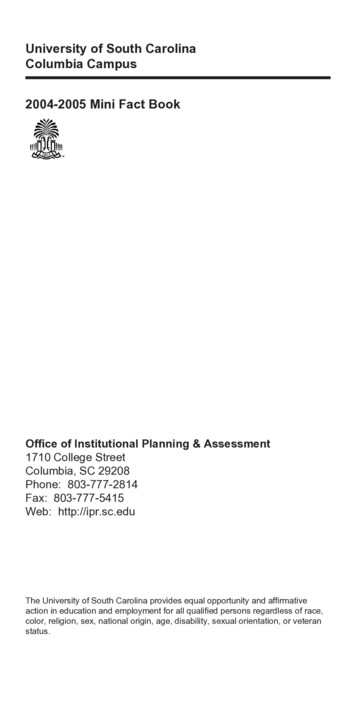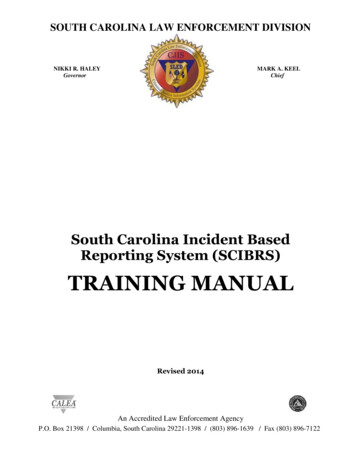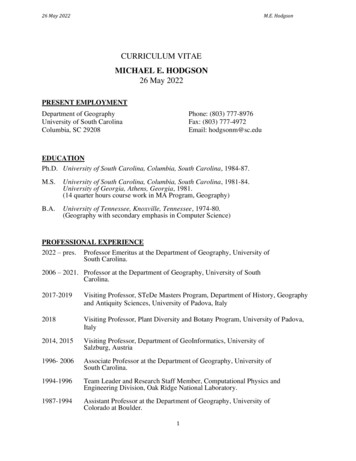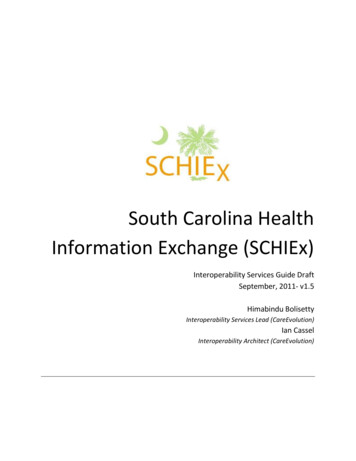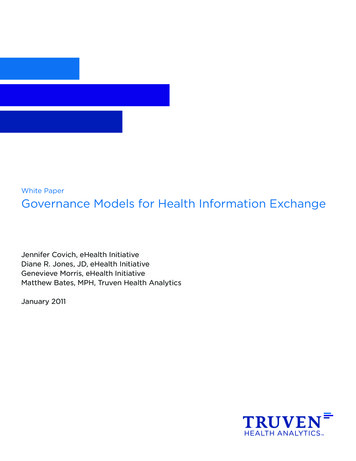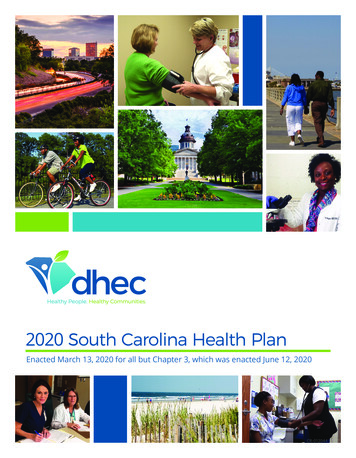
Transcription
2020 South Carolina Health PlanEnacted March 13, 2020 for all but Chapter 3, which was enacted June 12, 2020CR-0120446/17
SOUTH CAROLINA HEALTH PLANNING COMMITTEEMEMBERREPRESENTINGVacantProviderBradley W. MoorhouseProvider6/30/2016Gokul Gondi, M.D.Provider6/30/2021Rajeev Vasudeva, MDProvider6/30/2018Mary E. PhillipsBusiness Ann M. McCrawFinance/Business6/30/2018Sarah C. ntConsumerKurt E. MooreConsumer6/30/2018Steve E. NailConsumer6/30/2018L. Becky Dover. EsqConsumer Affairs (Ex-Officio)Rick LeeBoard of Health and EnvironmentalControlSouth Carolina Health Planning CommitteeDepartment of Health & Environmental ControlCertificate of Need Program2600 Bull StreetColumbia, SC 29201coninfo@dhec.sc.govPhone: (803) 545-4200EXPIRATION
TABLE OF CONTENTSPAGEChapter 1INTRODUCTION . . . . . . . . . . . . . . . . . . . . . . . . . . . . . . . . . . . . . . . . . . .South Carolina Health PlanCertificate of NeedHealth Planning CommitteeStatutory RequirementsDisclaimers111112Chapter 2INVENTORY REGIONS AND SERVICE AREAS . . . . . . . . . . . . . . . . .Inventory RegionsNeed For Health Care Facilities And Health ServicesService AreasTransfer Between Affiliated FacilitiesEstimated State Civilian PopulationInventory DatesDHEC Region Map44445667Chapter 3GENERAL HOSPITALS . . . . . . . . . . . . . . . . . . . . . . . . . . . . . . . . . .General HospitalsLong-Term Acute Care HospitalsCritical Access HospitalsPerinatal RegionsPerinatal Service LevelsObstetrical ServicesNeonatal ServicesCMS Diagnostic CategoriesGeneral Bed NeedLong-Term Acute Care Hospital InventoryCritical Access HospitalsPerinatal Regions MapPerinatal-Capable FacilitiesOB Utilization and BirthsIntensive and Intermediate Bassinets InventoryUtilization of Neonatal Special Care UnitsNICU Bed Need8813151516171821222930313233343637Chapter 4PSYCHIATRIC SERVICES . . . . . . . . . . . . . . . . . . . . . . . . . . . . . . . . . . .Community Psychiatric BedsState Mental Health FacilitiesPsychiatric Program InventoryPsychiatric Bed Need3838404244
Chapter 5REHABILITATION FACILITIES . . . . . . . . . . . . . . . . . . . . . . . . . . . . . .Rehabilitation Program InventoryRehabilitation Bed Need464850Chapter 6ALCOHOL AND DRUG ABUSE FACILITIES . . . . . . . . . . . . . . . . . . .Outpatient FacilitiesSocial Detoxification FacilitiesResidential Treatment Program FacilitiesInpatient Treatment FacilitiesOpioid Treatment ProgramsInpatient Treatment Facility InventoryInpatient Treatment Bed NeedOpioid Treatment Program Inventory515151515254565759Chapter 7RESIDENTIAL TREATMENT FACILITIES (RTF) FOR CHILDREN ANDADOLESCENTS . . . . . . . . . . . . . . . . . . . . . . . . . . . . . . . . . . . . . . . . . . .RTF for Children and Adolescents InventoryRTF for Children and Adolescents Bed Need606364Chapter 8CARDIOVASCULAR CARE . . . . . . . . . . . . . . . . . . . . . . . . . . . . . . . . . . .Cardiac CatheterizationsOpen Heart SurgeryCardiac Catheterization Procedure InventoryOpen Heart Procedure Inventory6565758284Chapter 9RADIATION ONCOLOGY . . . . . . . . . . . . . . . . . . . . . . . . . . . . . . . . . . . .Types of Radiation EquipmentMegavoltage VisitsRadiotherapy Inventory85879294Chapter 10OUTPATIENT FACILITIES . . . . . . . . . . . . . . . . . . . . . . . . . . . . . . . . . . . .Ambulatory Surgical FacilitiesFreestanding Emergency Hospital ServicesAmbulatory Surgery Facility UtilizationFreestanding Emergency Services Inventory95959799102Chapter 11LONG-TERM CARE FACILITIES AND SERVICES . . . . . . . . . . . . . . . . . . . .Nursing FacilitiesMedicaid Nursing Home PermitsCommunity Long-Term Care (CLTC) ProgramSpecial Needs FacilitiesInstitutional Nursing Facilities (Retirement Community103103104105106106
GlossaryNursing Facilities)Swing BedsHospice Facilities and Hospice ProgramsHome HealthLong-term Care InventoryLong-term Care Bed NeedMedicaid Patient Day AllocationSwing Bed ParticipantsInpatient Hospice FacilitiesHome Health Agency Inventory107108109113121122123124125.133
CHAPTER 1INTRODUCTIONSOUTH CAROLINA HEALTH PLANThe South Carolina Code of Laws requires the Department of Health and EnvironmentalControl (“Department”) to prepare a South Carolina Health Plan (“Plan”), with the advice ofthe Health Planning Committee, for use in the administration of the Certificate of NeedProgram. See § 44-7-180(B).CERTIFICATE OF NEEDThe purpose of the Certificate of Need Program, as set forth in the State Certification of Needand Health Facility Licensure Act (“Certificate of Need Act”), is to promote cost containment,prevent unnecessary duplication of health care facilities and services, guide theestablishment of health facilities and services which will best serve public needs, and ensurethat high quality services are provided in health facilities in this State. To achieve thesepurposes, the Certificate of Need Act requires a person or health care facility to obtain aCertificate of Need from the Department before undertaking certain health care relatedprojects. See §§ 44-7-120 and 44-7-160.HEALTH PLANNING COMMITTEEThe Health Planning Committee advises the Department in the drafting of the South CarolinaHealth Plan. It is comprised of fourteen members, twelve of whom are appointed by theGovernor, which must include at least one member from each congressional district. Onemember is appointed by the chairman of the Department’s Board, and by virtue of his office,the final member is either the South Carolina Consumer Advocate or his designee. Healthcare consumers, health care financiers (including business and insurance), and health careproviders (which must include at least one administrator of a for-profit nursing home) areequally represented. The Health Planning Committee reviews the South Carolina Health Planand submits it to the Board of Health and Environmental Control for final revision andadoption. See § 44-7-180.STATUTORY REQUIREMENTSIn accordance with § 44-7-180(B), this Plan contains (1) an inventory of existing and CONapproved health care facilities, beds, specified health services and equipment; (2) projectionsof need for additional healthcare facilities, beds, specified health services, and equipment; (3)standards for distribution of healthcare facilities, beds, specified health services, andequipment (“Certificate of Need Standards”); and (4) a general statement as to the project1
review criteria considered to be the most important in evaluating Certificate of Needapplications for each type of facility, service and equipment.(1) INVENTORYChapter 2 of this Plan identifies the inventory regions and service areas used in theadministration of the Certificate of Need Program. Healthcare facilities, specifiedhealth services, beds and equipment are inventoried where applicable.(2) PROJECTIONS OF NEEDChapters 3 through 11 of this Plan discuss the need for additional healthcare facilities,beds, specified health services and equipment in the State. While the methodologiesused to determine these needs vary depending on the type of healthcare facility, bed,specified health service, or equipment, a determination of projected need iscalculated for most areas addressed by the Plan.(3) CERTIFICATE OF NEED STANDARDSIn consultation with the Health Planning Committee, the Department formulatedthese standards to guide health providers throughout the State. Inclusion of thesestandards in the application process is designed to give applicants notice of itsrequirements and to elicit from them a commitment to incorporate these standardsinto both their applications and finished projects.(4) PROJECT REVIEW CRITERIAA general statement has been added to most sections of the Plan setting forth theProject Review Criteria considered to be the most important in reviewing Certificateof Need applications for each type of healthcare facility, bed, specified health service,and equipment. These criteria are not listed in order of importance, but sequentially,as they are in Regulation 61-15. Where appropriate, the Plan contains a finding as towhether the benefits of improved accessibility to each such type of facility, serviceand equipment may outweigh the adverse effects caused by the duplication of anyexisting facility, service or equipment.DISCLAIMERS(1)The hyperlinks provided throughout this Plan were checked for accuracy immediatelyprior to publication. Due to factors outside our control, we cannot guarantee the linkswill not expire or otherwise become unavailable after publication. Should you beunable to access the hyperlinked information, please feel free to request theinformation from the Certificate of Need Program via e-mail to coninfo@dhec.sc.gov.2
(2)The population data set forth in this Plan was received from the South CarolinaRevenue and Fiscal Affairs Office in August of 2019. The material includes populationprojections that are subject to the following conditions:These projections offer only one scenario of future population changeusing the most current data available. The overall accuracy of theprojections depends on the extent to which future events unfold in amanner that reflects previous trends observed within each group. Themodel cannot account for unprecedented events that may significantlyalter an area’s demographic composition in the future. The possibleevents include large factory openings or closings, changes intechnology, public health crises, environmental events, or otherconditions that could have an effect on migration, birth rates, or deathrates. This means that population projections are likely to be moreaccurate in the immediate future than in distant years into the future.The projections will be updated regularly as new data becomesavailable and future events unfold.Annual county populationestimates released by the Census Bureau will be monitored along withbirth and death data released each year, and adjustments will be madeto the projected population results as appropriate.3
CHAPTER 2INVENTORY REGIONS AND SERVICE AREASINVENTORY REGIONSThis Plan has adopted the Department’s regions for the purpose of inventorying Health CareFacilities and Health Services as designated and enumerated below:RegionCountiesI - UpstateAbbeville, Anderson, Cherokee, Greenville, Greenwood, Laurens,McCormick, Oconee, Pickens, Spartanburg, and UnionII - MidlandsAiken, Barnwell, Chester, Edgefield, Fairfield, Kershaw, Lancaster,Lexington, Newberry, Richland, Saluda and YorkIII - Pee DeeChesterfield, Clarendon, Darlington, Dillon, Florence, Georgetown,Horry, Lee, Marion, Marlboro, Sumter and WilliamsburgIV - LowcountryAllendale, Bamberg, Beaufort, Berkeley, Calhoun, Charleston,Colleton, Dorchester, Hampton, Jasper and OrangeburgNEED FOR HEALTH CARE FACILITIES AND HEALTH SERVICESThis Plan calculates the need for certain Health Care Facilities and Health Servicesthroughout South Carolina based on certain formulae and criteria set forth in detail in thisPlan. For example: The need for hospital beds is based on the utilization of individual facilities.The need for acute psychiatric services, alcohol and drug abuse services, andcomprehensive rehabilitation services is based on various service areas andutilization methodologies specified in this Plan.The need for most health services (e.g., cardiac catheterization, open heart surgery)is based upon the service standard, which is a combination of utilization criteria andtravel time requirements.The need for long-term care and skilled nursing service is projected by county.SERVICE AREASIn addition to inventory regions, this Plan designates service areas for certain Health CareFacilities and Health Services. These service areas may be comprised of one or more4
counties. Service areas may cross the inventory regions identified above. The need for aservice is analyzed by assessment of existing resources and need in the relevant service area,along with other factors set forth in this Plan, applicable statutes and regulations.TRANSFER BETWEEN AFFILIATED FACILITIESGiven the ever-changing nature of the health care delivery system, affiliated facilities maywant to transfer or exchange specific equipment, services, or licensed beds in order to bettermeet an identified need. Affiliated facilities are two or more health care facilities, whetherinpatient or outpatient, owned, leased, or who have a formal legal relationship with a centralorganization and whose relationship has been established for reasons other than fortransferring beds, equipment or services. In certain instances such a transfer or exchangeof acute services could be accomplished in a cost-effective manner and result in a moreefficient allocation of health care resources. This transfer or exchange of services applies toboth inpatient and outpatient services. A Certificate of Need is required to transfer or exchangebeds, services, and/or equipment. In order to evaluate a proposal for the transfer or exchangeof any health care equipment or technology reviewed under the Certificate of Need program,the following criteria must be applied to it:1.A transfer or exchange of beds, services, and/or equipment may be approved only ifthere is no overall increase in the number or amount of such beds and/or services.2.A transfer or exchange initiated under this Chapter may only occur within the servicearea(s) established in this Plan.3.The facility receiving the beds, services, and/or equipment must demonstrate theneed for the additional capacity based on historical and/or projected utilizationpatterns.4.The applicants must explain the impact of transferring the beds, services, and/orequipment on the health care delivery system of the county and/or service area fromwhich it is to be taken; any negative impact must be detailed, along with the perceivedbenefits of the proposal.5.The facility giving up beds, services, and/or equipment may not use the loss of suchbeds, services, and/or equipment as justification for a subsequent request toestablish or re-establish such beds, services, and/or equipment.6.A written contract or agreement between the governing bodies of the affiliatedfacilities approving the transfer or exchange of beds, services, and/or equipmentmust be included in the Certificate of Need process.7.Each facility giving up beds, services, and/or equipment must acknowledge in writing5
that this exchange is permanent; any further transfers would be subject to this sameprocess.ESTIMATED STATE CIVILIAN POPULATIONWhere these projections were required for calculations, this Plan has been developed usingthe estimated civilian population of 5,084,127 for 2018 and projected population of5,474,585 for 2024. All population data (county, planning area, and statewide) were providedby the South Carolina Revenue and Fiscal Affairs Office, Health and Demographics Section,in August 2019.INVENTORY DATESOnly those facilities reviewed under the Certificate of Need program are included in theinventory. The cut-off date for inclusion of information in this Plan was January 17, 2020.Inventory and utilization data set forth in this Plan is derived from the 2018 Joint AnnualReports (JARs). The period of time in which the individual data was collected is set forth bythe reporting entity in its individual JAR submission.6
DHEC REGIONS MAP(Chapter 2)UPSTATEMIDLANDSPEE DEELOWCOUNTRY7
CHAPTER 3GENERAL HOSPITALSGENERAL HOSPITALSRelevant Definitions“Hospital” means a facility organized and administered to provide overnight medical,surgical, or nursing care of illness, injury, or infirmity and may provide obstetrical care, andin which all diagnoses, treatment, or care is administered by or under the direction ofpersons currently licensed to practice medicine, surgery, or osteopathy.Hospital may include residential treatment facilities for children and adolescents in need ofmental health treatment which are physically a part of a licensed psychiatric hospital. Thisdefinition does not include facilities which are licensed by the Department of Social Services.“Hospital Bed” means a bed for an adult or child patient. Bassinets for the newborn in amaternity unit nursery, beds in labor rooms, recovery rooms, and other beds usedexclusively for emergency purposes are not included in this definition.Bed CapacityFor existing beds, capacity is considered bed space designated exclusively for inpatient care,including space originally designed or remodeled for inpatient beds, even thoughtemporarily not used for such purposes. The number of beds counted in any patient roomis the maximum number for which adequate square footage is provided, except that singlebeds in single rooms have been counted even if the room contained inadequate squarefootage.Inventory and Bed NeedAll licensed general hospitals, including Federal facilities, and CON-approved generalhospitals are listed in the inventory. Patient days and admissions are as reported bythe hospital in its JAR. The number of patient days utilized for the general hospital bedneed calculations does not include days of care rendered in licensed psychiatric units,substance abuse units, or comprehensive rehabilitation units of hospitals. These daysof care are shown in the corresponding inventories for each type of service. In addition,the days of care provided in Long-Term Care hospitals are not included in the general bedneed calculations.Total capacity by survey refers to a total designed capacity or maximum number of bedsthat may be accommodated as determined by an on-site survey. This capacity mayexceed the8
number of beds actually set up and in use. It may also differ from the licensed capacity,which is based on State laws and regulations. Beds have been classified as conforming andnonconforming, according to standards of plant evaluation.Variable Occupancy RateThe General Acute Hospital bed need methodology uses the following variable occupancyrate factors:0 - 174 bed hospitals Æ 65%175 - 349 bed hospitals Æ 70%350 bed hospital Æ 75%The population and associated utilization are broken down by age groups. The use ratesand projected average daily census are made for the age cohorts of 0-17, 18-64, and 65 andover, in recognition that different population groups have different hospital utilization rates.Where the term “hospital bed need” is used, these figures are based upon utilization data forthe general acute hospitals. This term does not suggest that facilities cannot operate athigher occupancy rates than used in the calculations without adding additional beds.AvailabilityThe need for general hospital beds is determined through the consideration of currentutilization and projected population growth with the goal of having beds available withinapproximately 30 minutes’ travel time for the majority of the residents of the State.CERTIFICATE OF NEED PROJECTION AND STANDARDS1.Calculations of hospital bed need are made for individual hospitals and for serviceareas.2.For individual hospitals, the methodology for calculating bed need is as follows:a.Determine the current facility use rate by dividing the 2018 patient days by the2018 population in each of the three age cohorts.b.Multiply the current facility use rate for each age cohort by the projectedpopulation by age cohort and divide by 365 to obtain a projected average dailycensus (ADC) by age cohort.c.Divide the sum of the age cohort projected ADC by the variable occupancyfactor (.65/.70/.75) to determine the hospital’s bed need.9
d.3.The number of additional beds needed or excess beds for the hospital isobtained by subtracting the number of existing and approved beds from thehospital’s bed need.The methodology for calculating the statewide utilization bed need for a service areais as follows:a.Divide the statewide total patient days by 365 to determine the statewideaverage daily census.b.Divide the statewide average daily census by the statewide occupancy factor(.75) to determine the total statewide bed need.c.Divide the statewide bed need by the 2018 statewide population to generatea bed-per-population (BPP) multiplier.d.For each service area, multiply the projected population by the BPP multiplierto determine the service area bed need, then subtract the total number ofexisting and approved beds to determine the statewide utilization bed needfor the service area.4.The bed need for each service area is the combined bed need for all individualhospitals in the service area. The bed need for service areas with no hospital, orfor service areas in which no hospital has reported any utilization data on the mostrecent JAR, is the statewide utilization bed need.5.If a service area indicates a surplus of beds, then no additional beds will be approvedunless an individual hospital in the service area indicates a need for additional beds.Should an individual hospital indicate a need for additional beds, then a maximum ofthe actual projected bed need or up to 50 additional beds may be approved for thathospital to allow for the construction of an economical unit at either the existinghospital site or another site, if the existing hospital is relocating or has relocated inwhole or in part to that site. The hospital requesting the addition must document theneed for additional beds beyond those indicated as needed by themethodology stated above, based on historical and projected utilization, as wellas projected population growth or other factors demonstrating the need for theproposed beds. Additional beds will only be approved for the specific hospitalindicating a need.6.If there is a need for additional hospital beds in the service area, then any entitymay apply to add these beds within the service area, and any entity may beawarded the Certificate of Need for these beds. If the number of beds needed is lessthan 50, then up to a total of 50 beds could be approved for any entity at any10
location within the service area.An applicant requesting additional bedsbeyond those indicated as needed by the methodology stated above mustdocument the need for additional beds based on historical and projectedutilization, projected population growth that has not been considered in this Planor other factors demonstrating the need for the proposed beds. It is up to theapplicant to document the need and the potential negative impact on the existingfacilities.7.A facility may apply to create a new additional hospital at a different site within thesame service area through the transfer of existing licensed beds, the projected bedneed for the facility, or a combination of both existing beds and projected bed need.The facility is not required to have a projected need for additional beds in order tocreate a new additional hospital. There is no required minimum number of beds inorder to approve the CON application. The applicant must justify, through patientorigin and other data, the need for a new hospital at the chosen site and the potentialadverse impact a new hospital at the chosen site could have on the existing hospitalsin the service area.8.No additional hospital will be approved unless it is a general hospital and will provide:9.a.A 24-hour emergency services department that meets the requirements to bea Level III emergency service as defined in the Emergency Services section ofRegulation 61-16;b.Inpatient medical services to both surgical and non-surgical patients; andc.Medical and surgical services on a daily basis within at least six of the majordiagnostic categories as recognized by Centers for Medicare and MedicaidServices (CMS). Any applicant for a new hospital must provide a writtencommitment that the facility will accept Medicare and Medicaid patients andthat unreimbursed services for indigent and charity patients are provided at apercentage that meets or exceeds other hospitals in the service area. The CMSDiagnostic Categories Chart is located at the end of this Chapter.Due to the low utilization and the low capital cost of converting hospital-basednursing home, psychiatric, rehabilitation and/or substance abuse beds to generalacute care hospital beds, the following policies may apply:a.Hospitals that have licensed nursing home beds within the hospital may beallowed to convert nursing home beds to general acute care hospital beds onlywithin the hospital, provided the hospital can document an actual need foradditional general acute care beds. Need will be based on actual utilization,using current information. A Certificate of Need is required for this conversion.11
b.Existing acute care hospitals that have inpatient psychiatric, rehabilitation, orsubstance abuse beds may be allowed to convert such beds to acute carehospital beds, regardless of the projected need for general acute care hospitalbeds. A Certificate of Need is required for this conversion.10.In some areas of South Carolina, a considerable influx of tourists is not counted in thepermanent population. If an individual hospital in these areas can document anddemonstrate the need for additional beds due to non-resident (tourist) populationand seasonal utilization fluctuations due to this population, then, based on furtheranalysis, the Department may approve some additional beds at the existing hospital.11.Should the deletion of services at a federal facility result in an immediate impact onthe utilization of a hospital, then the Department may approve a request foradditional beds at the affected hospital. The affected hospital must document theincrease in demand and explain why additional beds are needed to accommodatepatients previously served at the federal facility.12.Changes in the delivery system due to health care reform have resulted in theconsolidation of facilities and the establishment of provider networks. Theseconsolidations and agreements may lead to situations where affiliated hospitals maywish to transfer beds between themselves in order to serve their patients in a moreefficient manner. A proposal to transfer or exchange hospital beds requires a Certificateof Need and must comply with the provisions outlined in Chapter 2, Transfer betweenAffiliated Facilities.13.Factors to be considered regarding modernization of facilities include:14.a.Functional arrangement of the facility as it relates to efficient handling ofpatients and related workloads.b.The ability to update medical technology within the existing plant.c.Existence of The Joint Commission (TJC) or other accreditation bodydeficiencies or “grandfathered” licensure deficiencies.d.Cost efficiency of the existing physical plant versus plant revision, etc.e.Private rooms are now considered the industry standard.Each modernization proposal must be evaluated on the basis of merit, cost efficiency,and impact on healthcare delivery within the service area.The Hospital Bed Need Chart is located at the end of this Chapter.12
RELATIVE IMPORTANCE OF PROJECT REVIEW CRITERIAThe following project review criteria are considered to be the most important in evaluatingCertificate of Need applications for this service:1.2.3.4.5.6.Compliance with the Need Outlined in this Section of this Plan;Community Need Documentation;Distribution (Accessibility);Acceptability;Ability to Complete the Project; andAdverse Effects on Other Facilities.General hospital beds are typically located within approximately thirty (30) minutes’ traveltime for the majority of the residents of the State. The benefits of improved accessibilitywill be equally weighed with the adverse effects of duplication in evaluating Certificate ofNeed applications for these beds.LONG-TERM ACUTE CARE HOSPITALSLong-Term Acute Care Hospitals (LTACHs) are hospitals with an average Medicare inpatientlength of stay of greater than 25 days, including all covered and non-covered days of stay ofMedicare patients. They provide treatment to patients with complex medical conditions,such as strokes, cardiac care, ventilator dependency, wound care and post-surgical care.A LTACH may be either a freestanding facility or may occupy space in another hospital(“hospital-within-a-hospital”). Hospitals must meet additional federal criteria in order toqualify as a LTACH under the “hospital-within-a-hospital” model:1.The new LTACH must have a governing body, which is distinct and separate from thegoverning body of the host hospital, and the new body cannot be under the controlof the host hospital or any third entity that controls both hospitals.2.The LTACH must have a separate Chief Executive Officer through whom alladministrative authority flows, who is not employed by, or under contract with, thehost hospital or any third entity that controls both hospitals.3.The LTACH must have a separate Chief Medical Officer who reports directly to thegoverning body and is responsible for all medical staff activities. The Chief MedicalOfficer cannot be under contract with the host hospital or any third entity thatcontrols both hospitals.13
4.The LTACH must have a separate medical staff which reports directly to the governingbody, and adopt bylaws governing medical care, including granting privileges toindividual practitioners.CERTIFICATE OF NEED PROJECTIONS AND STANDARDS1.An application for a LTACH must be in compliance with the relevant standards inRegulation 61-16 (Minimum Standards for Licensing Hospitals and Institutional GeneralInfirmaries).2.Although LTACH beds are not considered to be a separate category for licensingpurposes, they will be inventoried separately from general acute care hospital bedsfor planning purposes.3.The utilization of LTACHs is not included in the bed need for general acute carehospital beds. No bed need will be calculated for LTACH beds. An applicant mustdocument the need for LTACH beds based on the utilization of existing LTACH beds.4.A hospital that has leased general beds to a LTACH shall be entitled to regain thesebeds once the lease is terminated. No entity other than the hospital (or its succ
2020 South Carolina Health Plan Enacted March 13, 2020 for all but Chapter 3, which was enacted June 12, 2020 CR-012044 6/17. . want to transfer or exchange specific equipment, services, or licensed beds in order to better meet an identified need. Affiliated facilities.





